At Home Yoga For Beginners- Getting Started
At home yoga for beginners? Yes, you can do it! Maybe you took a class or practiced at home with a video and felt lost, confused, uninspired, or even discouraged? Or maybe you don’t know how to get started or you think that you are not flexible enough? Don’t let that any of those things bring you down or deter you from adding a yoga practice to your daily life!
This post contains affiliate links. I earn from qualifying purchases. This means that I may earn a commission should you choose to sign up for a program or make a purchase using my link. This is at no extra cost to you. I only recommend products that I truly believe are helpful. See our Privacy Policy and Disclosures.
Keep reading for some tips to help you get started with practicing at home yoga for beginners.
There are so many wonderful benefits that come from doing yoga! If you are interested in some research and articles about the many benefits of yoga and are interested in diving into some science- take a look here:
Exploring The Therapeutic Effects Of Yoga And Its Ability To Increase Quality Of Life
If not, keep reading for some tips on getting started, some things to keep in mind, and some common modifications to many poses that may be categorized as for beginners (but don’t seem like it to you right now). Keep in mind that yoga is much more than a physical practice. And it is very much a practice- there is so much to learn and it is really a lifelong journey. Here are some more resources and research that you may be interested in.
Yoga: What You Need To Know: NIH
The Yoga Sutra: Your Guide To Living Every Moment
There are 8 Limbs Of Yoga and by practicing any of them – you are doing yoga. You may be surprised to know that the asana (the poses) is a very small part of yoga. Western culture has really made this the primary feature of yoga- but it is a part of a bigger whole. Keep that in mind as you begin your own at home yoga for beginners practice. The wonderful thing about yoga is that you can always find something new to explore.

12 Yoga Tips For Absolute Beginners: At Home Yoga For Beginners
Before you take a look at these tips, take a quick moment and think about why you are starting the practice to begin with. Are you interested in the physical part or the breath work? Are you doing it for the benefits of stress reduction or as part of adding more mindfulness practices to your life?
Of course, these reasons may probably change as you develop a more consistent practice, but having an understanding of why we are doing something can help us stay more consistent. What do you want to get out of starting your yoga practice? It is also perfectly fine if you don’t have an answer to that question!
1. We don’t do yoga asana to get better at doing yoga- we practice yoga to get better at doing life
Yes the physical part will certainly help our posture, strengthen our muscles, improve our core connection, our breathing- and so forth – but overtime you will find that it will help you in your everyday life both mentally and physically. Try to tune in and be aware of the changes you experience. It will be different for everyone.
There are many types of yoga so do not be afraid to explore. You can even change it up day to day. You don’t have to do power yoga sculpt to have it count! Vinyasa style yoga is a faster flowing style of practice and these may or may not appeal to you.
Try restorative yoga, yin yoga, hatha yoga, chair yoga, iyengar style- so many possibilities to try. Find something that resonates with you:
Yoga for Beginners: A Guide to the Different Types of Yoga
2. Do not get hung up on the phrase- full expression
Everyone has a different body and poses will look different on each of those bodies. For me, that term implies that if you can not do something a particular way, then you are not doing it at all. And that is simply not true. There are many variations of poses- not just one.
3. Do what is right for you -always
Do not compare yourself to anyone else. If something doesn’t feel right- it probably isn’t! Do not cram yourself into positions or poses that cause pain and strain.
Of course- there is a big difference between pain and effort. We do need to exert some effort, but no pain no gain is not welcome here as far as I am concerned. It is called a yoga practice for a reason- not perfection.
4. Change it up
Not all teachers will resonate with you – and that is okay. This goes for in person classes as well as online. Give it a decent try – and then simply find another class.
5. You do not need fancy clothes or any fancy equipment
If you are just getting started – a simple mat and block are fine. If you find that it is worth investing in more expensive versions at some point, that is up to you. A yoga mat is good to have for non-slip purposes and having a proper grip with your hands and feet. But there are plenty of poses that you can do on your back or seated – or even in your bed- that will be fine to practice on a rug, carpet, or towel.
6. Do not think that more is always better
While there can be benefits to a full hour long yoga class- you have time to get in all the good stuff ( grounding, breathwork, asana, mantra, meditation, and a full savasana (the final resting pose). There are benefits to smaller yoga “snacks” If you have 5-10 minutes you can use that time to help you get centered, energized, calm – you name it! It does not have to be all or nothing. Don’t be derailed because you don’t think that you have time to fit it to an already busy day.
7. Have some fun with it
Yoga can open up a whole new avenue for you. Take some of that mindfulness practice and use it to evaluate things in your life that are not working for you. Use it to make room for things that will.
8. Learn something new!
Yoga can help us be lifelong learners. A yoga practice can help us expand our interests. Lifelong learning can help our brains and our memory. Read some books on yoga or listen to some podcasts to get some new ideas. Take a look at this article if you are interested in some research on the memory boosting effects of yoga:
To reduce pre-Alzheimer’s cognitive impairment, get to the yoga mat
9. Add props
Do not be afraid to add props- blocks, straps, bolsters. Use what you need. Take a look at the images below for some tips for adding blocks to some beginner poses. Modifications should always be welcome. If you are in a class and the teacher does not offer any modifications- you may want to look into a different class. There is no one size fits all here.
10. Listen to yourself
Always go at your own pace. If you feel like you want to stay in a pose for a bit longer- do so. If you feel like a pose is not working for you, don’t be afraid to change it up. Just remember why you are doing it.
11. Be patient
Keep in mind that the effects of any mindfulness practice – including yoga – are cumulative. Some effects you may feel immediately, but long term practice will reap long term reward. Remember to really check in with yourself on a routine basis and see how you are feeling. Are you feeling more calm, can you handle stressful situations with more ease, do you have more patience with yourself and others, do you feel more mobile, have more energy?
12. Don’t strive for perfection
And finally there is no such thing as being good at doing yoga- do not compare yourself to others – just like in life! You carved out the time and you showed up for yourself- That is all you need to do.
Tips For Modifications For Beginners: The Power Of The Yoga Block
Remember that these tips go for any type of yoga- including chair yoga! When it comes to adding props – there are many to choose from. A yoga block is a simple tool to help you get started. Take a look at these modifications for some beginner poses that use a block. A foam block is lightweight and great for restorative poses. Cork blocks are more sturdy if you are putting a lot of weight through them, as well as being eco friendly. Having a set of two can be very helpful.
Here are two relatively inexpensive options to get started: yoga block or set of two
Here are 4 ways to use a block in chair yoga
1. Chair Yoga Mountain Pose
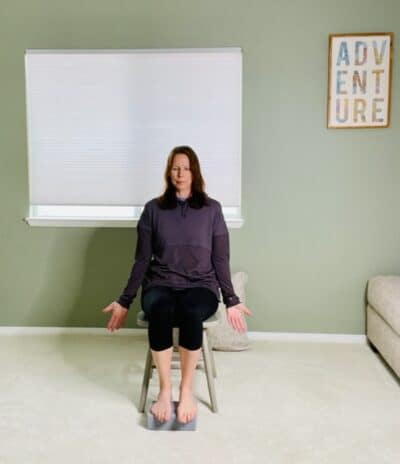
Yoga blocks are great props to help position the hips and knees in proper alignment and help us place our feet evenly on the floor. If we are seated all the way back in the chair for support, our feet may not reach the floor. Yoga blocks are a great help here.
2. Restorative Poses
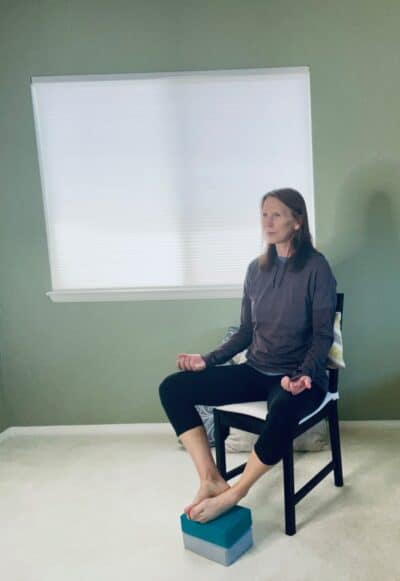
When we practice Resting or Restorative Poses, we don’t want to be straining to stay in our posture or pose. Props like a yoga block can help us here as well. Take a look at the Bound Angle Pose using a yoga block. We can get a better alignment on the hips and this allows us to get the hip opening stretch we are looking for.
3. Block Between The Knees
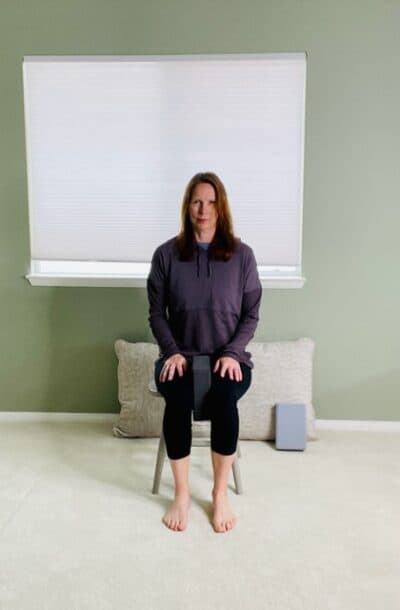
Adding a block between the knees can help us to improve our alignment in the hip, knee, and ankle as we practice upper body movements. It can also help us engage our core to improve our trunk alignment. The possibilities are really endless here.
4. Added Support
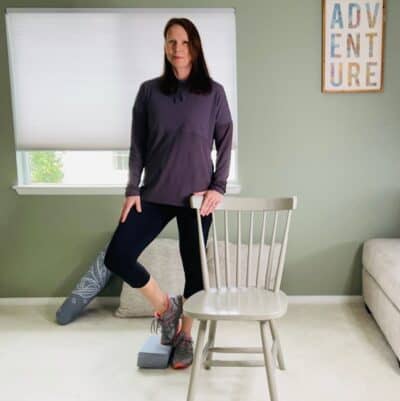
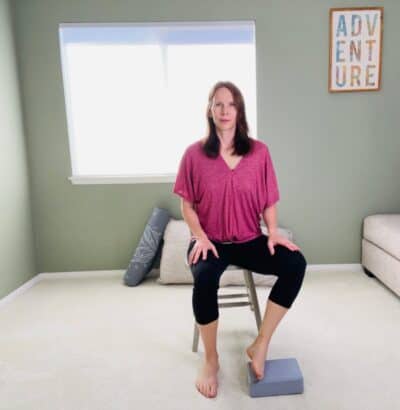
A yoga block can help a great deal with standing yoga poses, as well as help us get into poses that may be beneficial to us but we just need a bit of help. Take a look at the Seated Half Pigeon and the Standing Tree Pose for some ideas of how a yoga block can help us here.
5 Common Beginner Poses On The Mat
Sometimes poses that are called Beginner Poses can sometimes feel not so beginner and it can be discouraging. While this list is certainly not exhaustive, take a look at how you can use a block here to get the idea. I know that sometimes just simply sitting crossed legged on the floor can cause stress and discouragement before you have even begun!
1. Easy Pose With Block
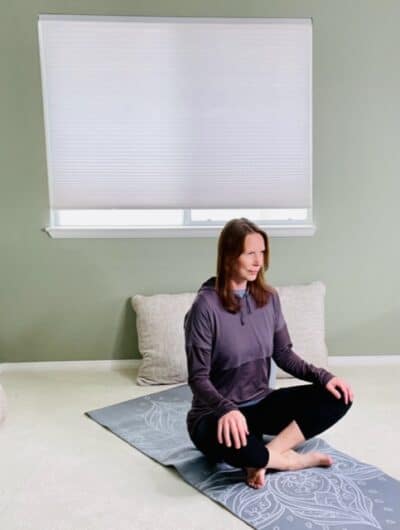
Many yoga practices may start by sitting in a cross legged position, but when hips are tight and not warmed up- this can be really uncomfortable. If we are straining to have our hips in this position, it will affect our spine and we may tend to round forward. Sitting up on a block can really help here. You can of course also use pillows, towels, or blankets.
This pose is often used as a place for centering and breath work, so make yourself comfortable here so you can focus on the good stuff.
2. Child’s Pose
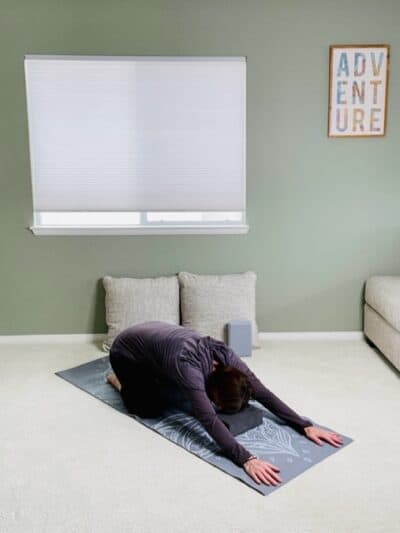
This is often considered a resting pose. However, it may not feel like it to everyone. There are many ways to add a block here. You can place it under the forehead to lessen any strain. Another option is to add a rolled up blanket or pillow on top of your calves. Play around here and find what works for you.
3. Downward Facing Dog
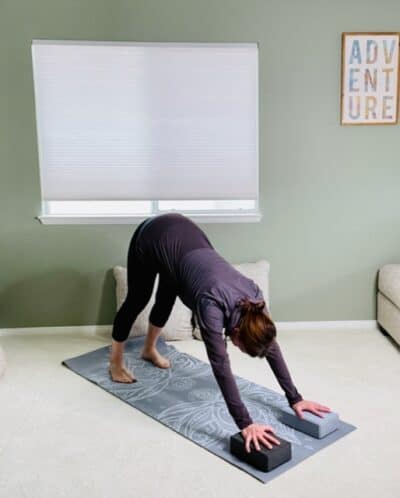
You are most likely familiar with this pose and it may look simple -but it really isn’t. Adding blocks under the hands can help decrease strain on the shoulders and hamstrings as you work to increase range of motion and strength.
If you find this posture is taxing on the wrists, a wonderful option is to use a chair as shown below. This brings me back to the tip from above- don’t force or strain!
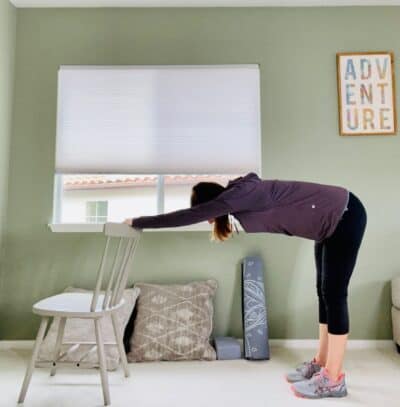
4. Forward Fold
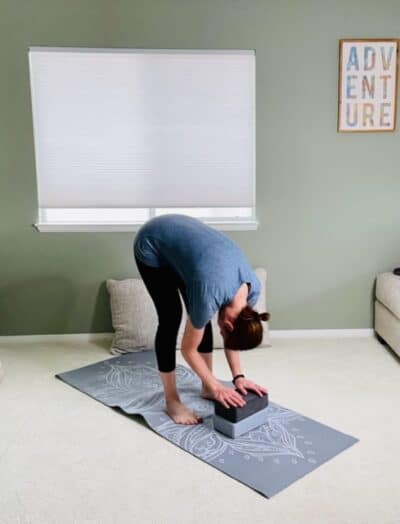
Don’t think that you can not do yoga because you are not flexible. All you need is a flexible mind! If the Forward Fold is discouraging you, add some blocks and bring the ground up to meet you. That same idea can apply to many other poses as well.
5. Spinal Twist
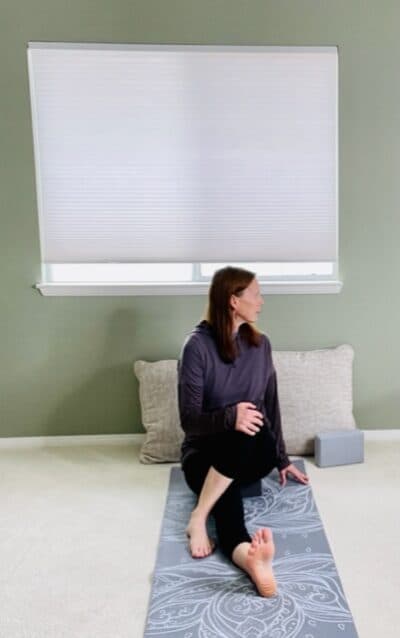
Just like in our Easy Pose, sitting up on a block helps our spinal alignment here. When we practice twists we want to elongate the spine as best that we can. Adding a block here can help us maintain a long spine without collapsing in our chest. (I am sitting on a block here)
The possibilities are really endless. We can of course use blocks for standing balancing poses and a host of restorative poses. But, these are some simple tips for common beginner poses that can give you some ideas. Now you may have some things to think about as you start your own personal yoga practice. Let me know how it goes!
Here are some beginner videos to help you get started:
Chair Yoga Poses To Move And Stretch
Yoga For Beginners- 10 Minutes
30 Day Yoga Challenge- For Beginners (Yoga With Bird)
Mat Yoga For Beginners- 30 Minutes
Yoga For Beginners With Jesse Richburg
Want More?
If you are new to chair yoga and would like more information on chair yoga poses for beginners, take a look at Is Chair Yoga Right for You?
Keeping track of your habits can be helpful with staying on track of your goals, you may enjoy this simple Daily Habit Tracker Notebook
I invite you to take a look at Tips For Reducing Stress With Rest if you are interested in finding more balance in you life
Take a look at the 21 Day Mindfulness Challenge for some simple and practical activities to help you feel more present
Or, you may be interested in Health And Wellness: 5 Simple Tips
Visit The Peaceful Chair Etsy Shop to see if there is anything of interest to you!
I invite you to sign up for the Monthly Email Newsletter to stay up to date on the latest blog posts and videos
Namaste!
Disclaimer: The Peaceful Chair and thepeacefulchair.com strongly recommends that you consult with your physician before starting this or any exercise program.The information provided on this website is for informational purposes only and is not to be used in place of medical advice or information from your healthcare provider. Neither The Peaceful Chair, the peacefulchair.com, nor any of its contributors shall be held liable for any improper or incorrect use of the information described and/or contained herein and assumes no responsibility for anyone’s use of the information contained in any links, videos, or any content on this website.

Leave A Comment